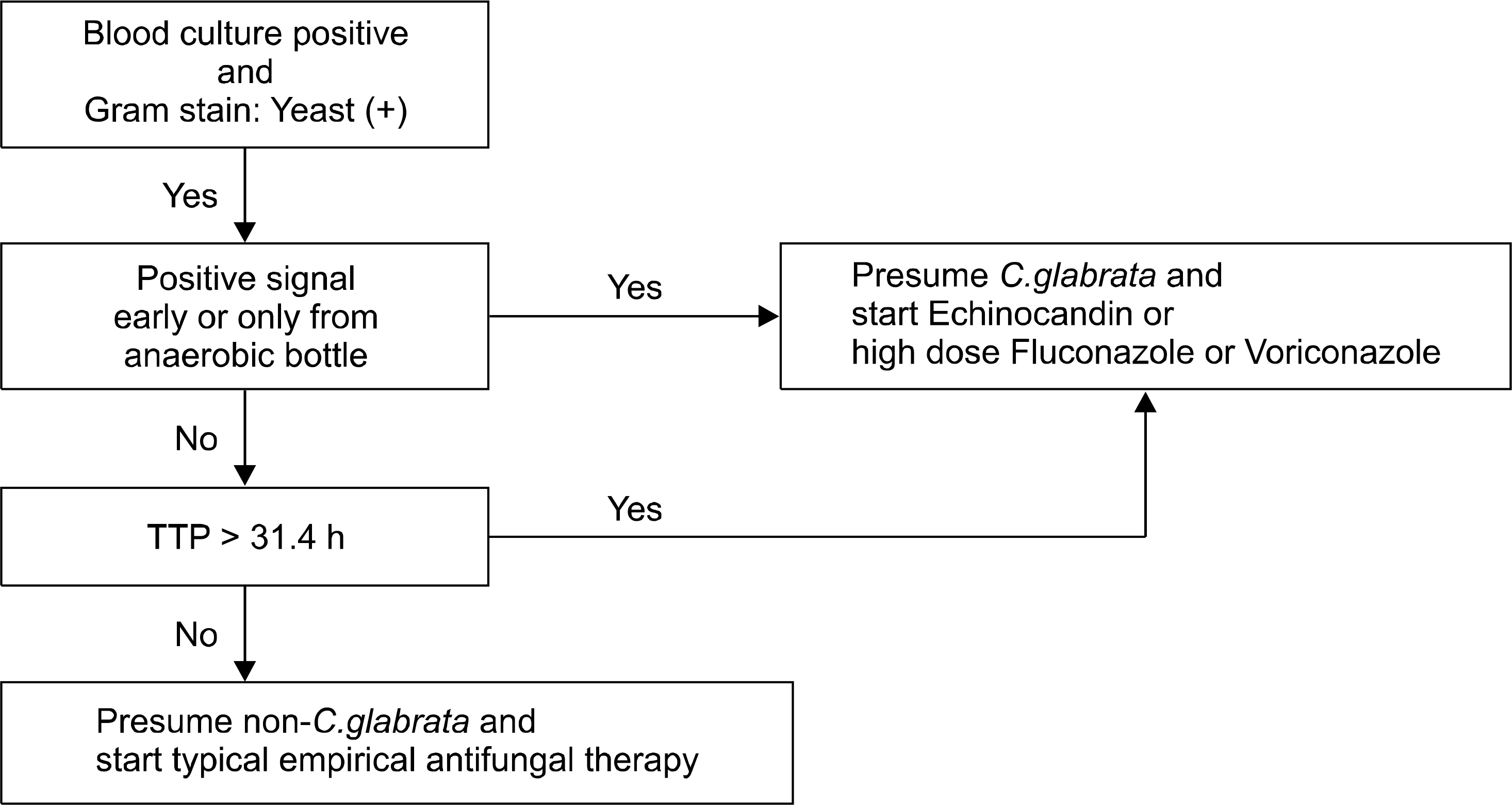Abstract
Background
Fast identification of Candida glabrata is important, because empirical antifungal therapy for fungemia with C. glabrata and non-C. glabrata varies. We proposed an algorithm for rapid presumptive diagnosis to identify fungemia with C. glabrata using earlier or only growth from anaerobic bottles and longer time to positivity (TTP) in blood cultures.
Methods
Positivity and TTP using the BacT/Alert 3D system (bioMerieux Inc, USA) with resin bottles (FA Plus and FN Plus) were analyzed in 215 candidemia patients from June 2014 to June 2016 in a uni-versity-affiliated hospital in Korea.
Results
A higher proportion of earlier or only growth from anaerobic bottles was observed in C. glabrata (38.8%, 7/18) than in C. albicans (7.6%, 8/105), C. parapsilosis (10.5%, 4/138), and C. tropicalis (9.2%, 5/54) (P=0.006). The mean (±standard deviation) TTP for C. glabrata was 41.7 h (±16.3 h) compared with 26.7 h (±15.9 h) for C. albicans, 33.4 h (±8.4 h) for C. parapsilosis, and 23.1 h (±17.3 h) for C. tropicalis (P<0.0001). We could predict fungemia with C. glabrata with a sensitivity of 94.4%, specificity of 63.9%, positive predictive value of 19.3%, and negative predictive value of 99.2% using a two-step algorithm: earlier or only growth from anaerobic bottles and TTP >31.4 h.
Go to : 
References
1. Pfaller MA, Diekema DJ, Jones RN, Sader HS, Fluit AC, Hollis RJ, et al. International surveillance of bloodstream infections due to Candida species: frequency of occurrence and in vitro susceptibilities to fluconazole, ravuconazole, and voriconazole of isolates collected from 1997 through 1999 in the SENTRY antimicrobial surveillance program. J Clin Microbiol. 2001; 39:3254–9.
2. Morrell M, Fraser VJ, Kollef MH. Delaying the empiric treatment of candida bloodstream infection until positive blood culture results are obtained: a potential risk factor for hospital mortality. Antimicrob Agents Chemother. 2005; 49:3640–5.
3. Pappas PG, Kauffman CA, Andes DR, Clancy CJ, Marr KA, Ostrosky-Zeichner L, et al. Clinical Practice Guideline for the Management of Candidiasis: 2016 Update by the Infectious Diseases Society of America. Clin Infect Dis. 2016; 62:e1–50.

4. Antinori S, Milazzo L, Sollima S, Galli M, Corbellino M. Candidemia and invasive candidiasis in adults: A narrative review. Eur J Intern Med. 2016; 34:21–8.

5. Kaur R, Domergue R, Zupancic ML, Cormack BP. A yeast by any other name: Candida glabrata and its interaction with the host. Curr Opin Microbiol. 2005; 8:378–84.

6. Song SA, Kim JH, Shin JH, Kim SH, Lee NY, Kim MN, et al. Clinical usefulness of routine use of anaerobic blood culture bottle. Ann Clin Microbiol. 2014; 17:35–41.

7. Foster N, Symes C, Barton R, Hobson R. Rapid identification of Candida glabrata in Candida bloodstream infections. J Med Microbiol. 2007; 56:1639–43.

8. Horvath LL, George BJ, Hospenthal DR. Detection of fifteen species of Candida in an automated blood culture system. J Clin Microbiol. 2007; 45:3062–4.
9. Cobos-Trigueros N, Kaasch AJ, Soriano A, Torres JL, Vergara A, Morata L, et al. Time to positivity and detection of growth in anaerobic blood culture vials predict the presence of Candida glabrata in candidemia: a two-center European cohort study. J Clin Microbiol. 2014; 52:3082–4.

10. Chen LY, Kuo SC, Wu HS, Yang SP, Chan YJ, Chen LK, et al. Associated clinical characteristics of patients with candidemia among different Candida species. J Microbiol Immunol Infect. 2013; 46:463–8.

11. Huang L, Zhang YY, Sun LY. Time to positivity of blood culture can predict different Candida species instead of pathogen concentration in candidemia. Eur J Clin Microbiol Infect Dis. 2013; 32:917–22.

12. Lai CC, Wang CY, Liu WL, Huang YT, Hsueh PR. Time to positivity of blood cultures of different Candida species causing fungaemia. J Med Microbiol. 2012; 61:701–4.

13. Haimi-Cohen Y, Vellozzi EM, Rubin LG. Initial concentration of Staphylococcus epidermidis in simulated pediatric blood cultures correlates with time to positive results with the automated, continuously monitored BACTEC blood culture system. J Clin Microbiol. 2002; 40:898–901.
Go to : 
 | Fig. 1.Two-step algorithm for a presumptive identification of C. glabrata to initiate empirical antifungal therapy. |
Table 1.
Comparison of the mean time to positivity (TTP) and standard deviation of BacT/Alert 3D system
Table 2.
Performance of algorithm using growth from anaerobic bottle and TTP (time to positivity)




 PDF
PDF ePub
ePub Citation
Citation Print
Print


 XML Download
XML Download